Spatially Differentiated Trends between Forest Pest-Induced Losses and Measures for Their Control in China
Abstract
1. Introduction
2. Materials and Methods
2.1. Literature Review
2.2. The Explanation of Spatial Distribution Factors
2.3. Simultaneous Equation Model (SEM) and Influencing Factors
3. Results and Discussion
3.1. Forest Pest Damage and Management Differences between the Southwest and the Northeast
3.2. Factors Influencing Forest Pest Control
3.3. Realistic Significance of the Influencing Factors on Forest Pest Outbreak
4. Conclusions
Author Contributions
Funding
Acknowledgments
Conflicts of Interest
Data Availability
References
- FAO. Global Forest Resources Assessment 2010—Main Report; FAO: Rome, Italy, 2010. [Google Scholar]
- Bradshaw, C.J.; Leroy, B.; Bellard, C.; Roiz, D.; Albert, C.; Fournier, A.; Barbet-Massin, M.; Salles, J.M.; Simard, F.; Courchamp, F. Massive yet Grossly Underestimated Global Costs of Invasive Insects. Nat. Commun. 2016, 7, 12986. [Google Scholar] [CrossRef] [PubMed]
- Dainese, M.; Schneider, G.; Krauss, J.; Steffan-Dewenter, I. Complementarity among Natural Enemies Enhances Pest Suppression. Sci. Rep. 2017, 7, 8172. [Google Scholar] [CrossRef] [PubMed]
- Oliveira, C.M.; Auad, A.M.; Mendel, S.M. Crop Losses and the Economic Impact of Insect Pests on Brazilian Agriculture. Crop Prot. 2014, 56, 50–54. [Google Scholar] [CrossRef]
- Song, Y.S.; Su, H.J.; Yu, H.Y. The Loss Assessment of Chinese Forest Pest Disasters. China For. Pests 2011, 6, 1–4. (In Chinese) [Google Scholar]
- Yajuan, L.I.; Chen, T.; Wang, J.; Wang, D. Temporal-Spatial Distribution and Formation of Historic and Cultural Villages in China. Geogr. Res. 2013, 32, 1477–1485. (In Chinese) [Google Scholar]
- Hu, H.Y. The Distribution of Population in China, with Statistics and Maps. Acta Geogr. Sin. 1935, 2, 33–74. (In Chinese) [Google Scholar]
- Gao, Y.; Zheng, J.; Bu, M. Rural-urban income gap and agricultural growth in China: An empirical study on the provincial panel data, 1978–2010. China Agric. Econ. Rev. 2014, 6, 92–107. [Google Scholar] [CrossRef]
- Hu, Z.; Wang, Y.; Liu, Y.; Long, H.; Peng, J. Spatio-Temporal Patterns of Urban-Rural Development and Transformation in East of the “Hu Huanyong Line”, China. ISPRS Int. J. Geoinf. 2016, 5, 24. [Google Scholar] [CrossRef]
- Delang, C.O. China’s Key Forestry Programs: Economic, Social and Ecological Rationales. Int. J. Glob. Environ. Issues 2016, 15, 281–299. [Google Scholar] [CrossRef]
- Ji, L.; Zhen, W.; Wang, X.; An, L. Forest Insect Pest Management and Forest Management in China: An Overview. Environ. Manag. 2011, 48, 1107–1121. [Google Scholar] [CrossRef]
- Fares, S.; Mugnozza, G.S.; Corona, P.; Palahí, M. Sustainability: Five Steps for Managing Europe’s Forests. Nat. News 2015, 519, 407–409. [Google Scholar] [CrossRef] [PubMed]
- Zidon, R.; Tsueda, H.; Morin, E.; Morin, S. Projecting Pest Population Dynamics under Global Warming: The Combined Effect of Inter- and Intra-Annual Variations. Ecol. Appl. 2016, 26, 1198–1210. [Google Scholar] [CrossRef] [PubMed]
- State Statistical Bureau. National Bureau of Statistics, 2003–2017. Available online: http://data.stats.gov.cn/easyquery.htm?cn=E0103 (accessed on 10 December 2018). (In Chinese)
- SFA. Forestry Statistics Yearbook (2003–2017); China Forestry Publishing House. Available online: http://navi.cnki.net/KNavi/YearbookDetail?pcode=CYFD&pykm=YCSRT&bh (accessed on 18 December 2018). (In Chinese).
- Häggman, H.; Raybould, A.; Borem, A.; Fox, T.; Handley, L.; Hertzberg, M.; Lu, M.Z.; Macdonald, P.; Oguchi, T.; Pasquali, G.; et al. Genetically Engineered Trees for Plantation Forests: Key Considerations for Environmental Risk Assessment. Plant Biotechnol. J. 2013, 11, 785–798. [Google Scholar] [CrossRef] [PubMed]
- Zhang, K.; Song, C.; Zhang, Y.; Zhang, Q. Natural disasters and economic development drive forest dynamics and transition in China. For. Policy Econ. 2017, 76, 56–64. [Google Scholar] [CrossRef]
- Zhao, Y.X.; Wu, J.; Luo, Y.Q.; Tao, J. Forest Invasion Insect Identification and Control Measures of China. Plant Quar. 2015, 29, 42–47. (In Chinese) [Google Scholar]
- Arvind, K.; Akhilesh, K. Effect of Abiotic and Biotic Factors on Incidence of Pests and Predator in Cowpea Vigna unguiculata. Legume Res. 2015, 38, 121–125. [Google Scholar] [CrossRef]
- Ge, X.; Chao, J.; Chen, L.; Qiu, S.; Zhao, Y.; Wang, T.; Zong, S. Predicting the Potential Distribution in China of Euwallacea fornicates (Eichhoff) under Current and Future Climate Conditions. Sci. Rep. 2017, 7, 906. [Google Scholar] [CrossRef]
- Blake, G.; Sandler, H.A.; Coli, W. An Assessment of Grower Perceptions and Factors Influencing Adoption of IPM in Commercial Cranberry Production. Renew. Agric. Food Syst. 2007, 22, 134–144. [Google Scholar] [CrossRef]
- Damos, P. Modular structure of web-based decision support systems for integrated pest management. A review. Agron. Sustain. Dev. 2015, 35, 1347–1372. [Google Scholar] [CrossRef]
- Sun, K.; Zhang, T.; Tian, Y. Dynamics analysis and control optimization of a pest management predator–prey model with an integrated control strategy. Appl. Math. Comput. 2017, 292, 253–271. [Google Scholar] [CrossRef]
- Rout, T.M.; Moore, J.L.; McCarthy, M.A. Prevent, search or destroy? A partially observable model for invasive species management. J. Appl. Ecol. 2014, 51, 804–813. [Google Scholar] [CrossRef]
- Stallman, H.R.; James, H.S., Jr. Determinants Affecting Farmers’ Willingness to Cooperate to Control Pests. Ecol. Econ. 2015, 117, 182–192. [Google Scholar] [CrossRef]
- Hoskins, W.M.; Borden, A.D.; Michelbacher, A.E. Recommendations for a More Discriminating Use of Insecticides. In Proceedings of the 6th Pacific Science Congress, Berkeley, CA, USA, 24 July–12 August 1939; pp. 119–123. [Google Scholar]
- Ullyett, E.C. Insects, Man and the Environment. J. Econ. Entomol. 1951, 44, 459–464. [Google Scholar] [CrossRef]
- FAO. Report of the First Session of the FAO Panel of Experts on Integrated Pest Control; FAO: Rome, Italy, 1967; Volume 9, pp. 18–22. [Google Scholar]
- Norton, G.A.; Holling, C.S. Proceedings of a Conference on Pest Management. Int. Inst. Appl. Syst. Anal. 1997, 10, 25–29. [Google Scholar]
- Bulmer, M.S.; Bachelet, I.; Raman, R.; Rosengaus, R.B.; Sasisekharan, R. Targeting an Antimicrobial Effector Function in Insect Immunity as a Pest Control Strategy. Proc. Natl. Acad. Sci. USA 2009, 106, 12652–12657. [Google Scholar] [CrossRef] [PubMed]
- Potter, K.; Conkling, B. Forest Health Monitoring: National Status, Trends and Analysis 2015; U.S. Department of Agric: Washington, DC, USA, 2017; Volume 198, pp. 1–213.
- Tang, S.; Xiao, Y.; Chen, L.; Cheke, R.A. Integrated Pest Management Models and Their Dynamical Behavior. Bull. Math. Biol. 2005, 67, 115–135. [Google Scholar] [CrossRef]
- Ordano, M.; Gullen, L.; Rull, J.; Lasa, R.; Aluja, M. Temporal Dynamics of Diversity in a Tropical Fruit (Tephritidae) Fly Ensemble and Their Implications on Pest Management and Biodiversity Conservation. Biodivers. Conserv. 2013, 22, 1557–1575. [Google Scholar] [CrossRef]
- Puente, M.; Darnall, N.; Forkner, R.E. Assessing Integrated Pest Management Adoption: Measurement Problems and Policy Implications. Environ. Manag. 2011, 48, 1013–1023. [Google Scholar] [CrossRef]
- Wyckhuys, K.A.G.; O’Neil, R.J. Local Agro-Ecological Knowledge and its Relationship to Farmers’ Pest Management Decision Making in Rural Honduras. Agric. Hum. Values 2007, 24, 307–321. [Google Scholar] [CrossRef]
- State Council of the People’s Republic of China. Forestry Pest Control Regulations. 1989. Available online: http://www.forestry.gov.cn/main/3950/content-459886.html (accessed on 14 March 2017). (In Chinese)
- State Forestry Administration (SFA). Major Exotic Forestry Pest Emergency Measures. 2005. Available online: http://www.forestry.gov.cn/portal/main/s/150/content-204816.html (accessed on 2 November 2007). (In Chinese)
- Dong, Z.H.; Xu, Y.; Cui, D.Y.; Chao, Y. Development and Application of Forecast Function in the Information Management System of Forest. China For. Pests 2017, 36, 9–12. (In Chinese) [Google Scholar]
- Qin, J.; Yang, X.; Yang, Z.; Luo, J.T.; Lei, X.F. New Technology of Using Meteorological Information in Forest Insect Pest Forecast and Warning Systems. Pest Manag. Sci. 2017, 73, 2509–2518. [Google Scholar] [CrossRef]
- Liu, P.; Liang, Q.L.; Chen, M.; Liu, Z.J.; Sheng, Z.H.; Su, Y.L. Construction on Index System of Forest pest Disaster Loss Assessment. Sci. Silvae Sin. 2016, 52, 101–107. (In Chinese) [Google Scholar] [CrossRef]
- Cai, Q.; Zhang, D.H.; Li, Y.; Zhu, L.Y. Empirical Study of Forest Pest Control Efficiency in China. For. Pest Dis. 2016, 3, 34–37. (In Chinese) [Google Scholar]
- SFPCA. The Notice of the Forest Pest Control “Forth Rate” Target during the 13th Five Years by SFA. 2016. Available online: http://www.forestpest.org/statutefile/lawunion/4028949e58e29b94015900e7097100b7.html (accessed on 15 December 2016). (In Chinese).
- Liu, J.; Li, S.; Ouyang, Z.; Tam, C.H.; Chen, X. Ecological and Socioeconomic Effects of China’s Policies for Ecosystem Services. Proc. Natl. Acad. Sci. USA 2008, 105, 9477. [Google Scholar] [CrossRef] [PubMed]
- Ma, A.G. China Forest Pest Situation; China Forestry Publishing House: Shenyang, China, 2008. (In Chinese) [Google Scholar]
- Chen, M.X.; Gong, Y.H.; Li, Y. Population Distribution and Urbanization on Both Sides of the Hu Huanyong Line: Answering the Premier’s Question. J. Geogr. Sci. 2016, 26, 1593–1610. [Google Scholar] [CrossRef]
- Yan, J. The Economic Analysis and Measures Study of Chinese Forestry Pest Disaster Management. Ph.D. Thesis, Beijing Forestry University, Beijing, China, 2008; p. 264. (In Chinese). [Google Scholar]
- Liu, C.; Liu, H.; Wang, S. Has China’s New Round of Collective Forest Reforms Caused an Increase in the Use of Productive Forest Inputs? Land Use Policy 2017, 64, 492–510. [Google Scholar] [CrossRef]
- Seidl, R.; Thom, D.; Kartz, M.; Martin-Benito, D.; Pettonie, M.; Vacchiano, G.; Jan, W.; Ascoli, D. Forest Disturbances under Climate Change. Nat. Clim. Chang. 2017, 7, 395. [Google Scholar] [CrossRef] [PubMed]
- Early, R.; Bradley, B.A.; Dukes, J.S.; Lawler, J.J.; Olden, J.D.; Blumenthal, D.M.; Gonzalez, P.; Grosholz, E.D.; Ibañez, I.; Miller, L.P.; et al. Global Threats from Invasive Alien Species in the Twenty-First Century and National Response Capacities. Nat. Commun. 2016, 7, 12485. [Google Scholar] [CrossRef]
- Meteorological Statistical Yearbook, 2003–2017; China Meteorological Press. Available online: http://navi.cnki.net/KNavi/YearbookDetail?pcode=CYFD&pykm=YZGQX&bh= (accessed on 6 September 2018). (In Chinese).
- Chen, Q. Advanced Econometrics and Stata Applications 2; Adv Educ Publishing House: Beijing, China, 2014. (In Chinese) [Google Scholar]
- Buckley, S.; Drinkall, N.J.; Thoms, E.M. Review of Research on the Control of Pine Wood Nematode (Bursaphelenchus xylophilus) using the Fumigant Sulfuryl Fluoride and Current Status for Inclusion in ISPM No.15. Julius-Kühn-Archiv 2010, 15, 848–853. [Google Scholar] [CrossRef]
- Mamiya, Y. Pathology of the Pine Wilt Disease Caused by Bursaphelenchus xylophilus. Annu. Rev. Phytopathol. 1983, 21, 201–220. [Google Scholar] [CrossRef]
- SFPCA. The Calendar of Forest Pest Control; China Forestry Publishing House: Beijing, China, 2010. [Google Scholar]
- Han, Y.; Wang, Y.; Xiang, Y.; Jianren, Y.E. Prediction of Potential Distribution of Bursaphelenchus xylophilus in China Based on Maxent Ecological Niche Model. J. Nanjing For. Univ. 2015, 39, 6–10. (In Chinese) [Google Scholar]
- SFA. Notice of the State Forest Administration (No.4 of 2017): Notice of Bursaphelenchus xylophilus Outbreak Regions. Available online: http://www.forestry.gov.cn/main/3600/content-941990.html (accessed on 20 January 2017). (In Chinese)
- SFPCA. Bursaphelenchus xylophilus. Available online: http://www.forestpest.org/quarantine/pest/40289447520b927501520b96613d0357.html (accessed on 22 May 2015). (In Chinese).
- Jindal, R.M.; Patel, T.G.; Waller, S.G. Public-Private Partnership Model to Provide Humanitarian Services in Developing Countries. J. Am. Coll. Surg. 2017, 224, 988–993. [Google Scholar] [CrossRef] [PubMed]
- Zhang, K.; Dearing, J.A.; Dawson, T.P.; Dong, X.; Yang, X.; Zhang, W. Poverty Alleviation Strategies in Eastern China Lead to Critical Ecological Dynamics. Sci. Total Environ. 2015, 506–507, 164–181. [Google Scholar] [CrossRef] [PubMed]
- Li, W.; Liu, Y.J.; Yang, Z. Preliminary Strategic Environmental Assessment of the Great Western Development Strategy: Safeguarding Ecological Security for a New Western China. Environ. Manag. 2012, 49, 483–501. [Google Scholar] [CrossRef] [PubMed]
- Seele, P.; Helbing, D. Boost sustainability through social justice in China’s Belt and Road Initiative. Nature 2018, 555, 311. [Google Scholar] [CrossRef] [PubMed]
- Tao-Zhong, T.L.; Yang, H. Discussion on the Essence of Tripartite Rural Land Entitlement System of Farmland Property Rights: Seeking the Appropriate Expression of Policy on Law. China Land Sci. 2017, 31, 64–72. (In Chinese) [Google Scholar]
- Qin, T.; Gu, X.; Tian, Z.; Pan, H.; Deng, J.; Wan, L. An empirical analysis of the factors influencing farmer demand for forest insurance: Based on surveys from Lin’an County in Zhejiang Province of China. J. For. Econ. 2016, 24, 37–51. [Google Scholar] [CrossRef]
- Shang, W.; Gong, Y.; Wang, Z.; Stewardson, M.J. Eco-compensation in China: Theory, practices and suggestions for the future. J. Environ. Manag. 2018, 210, 162–170. [Google Scholar] [CrossRef] [PubMed]
- Pimentel, D.; Zuniga, R.; Morrison, D. Update on the environmental and economic costs associated with alien-invasive species in the United States. Ecol. Econ. 2005, 52, 273–288. [Google Scholar] [CrossRef]
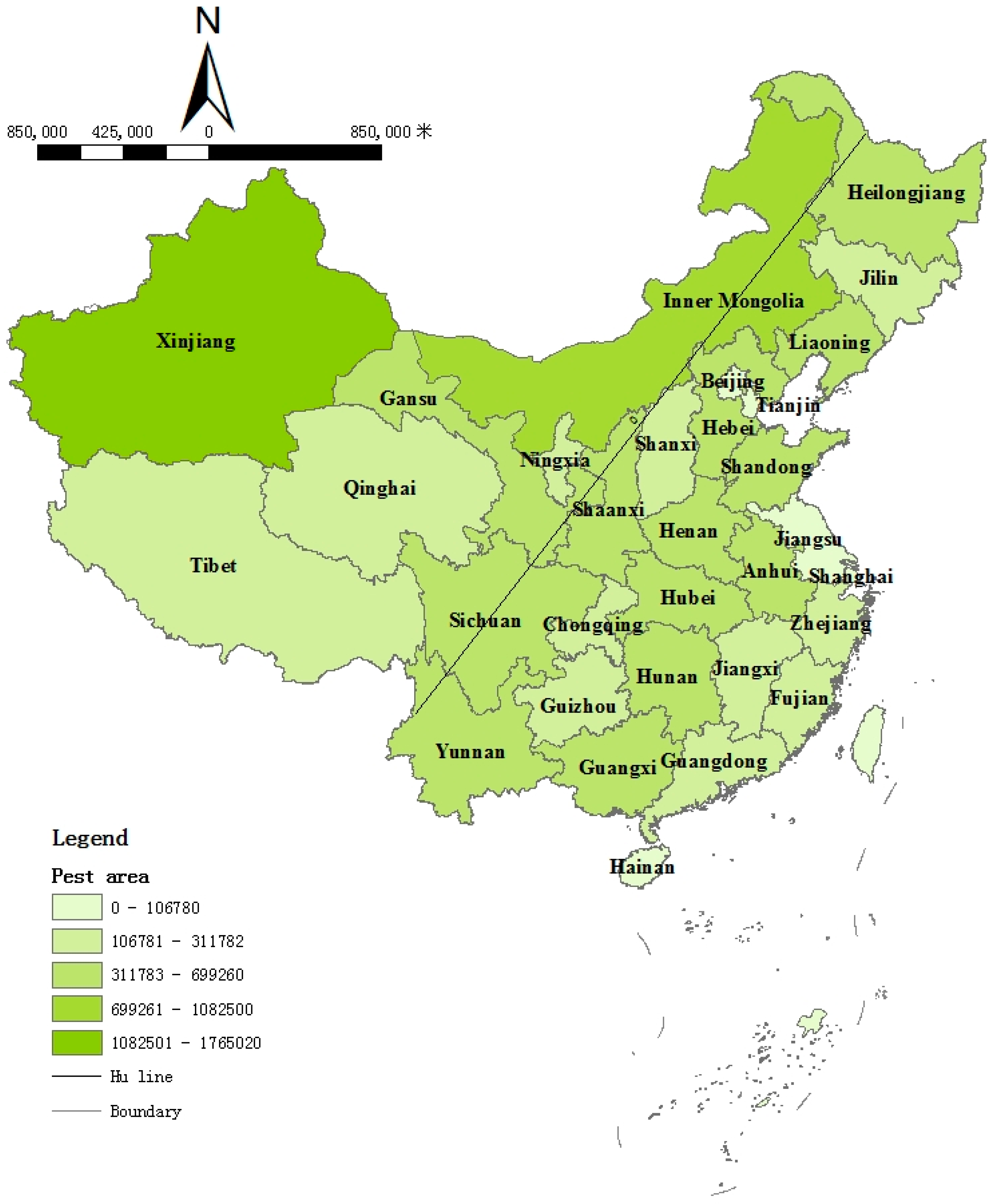
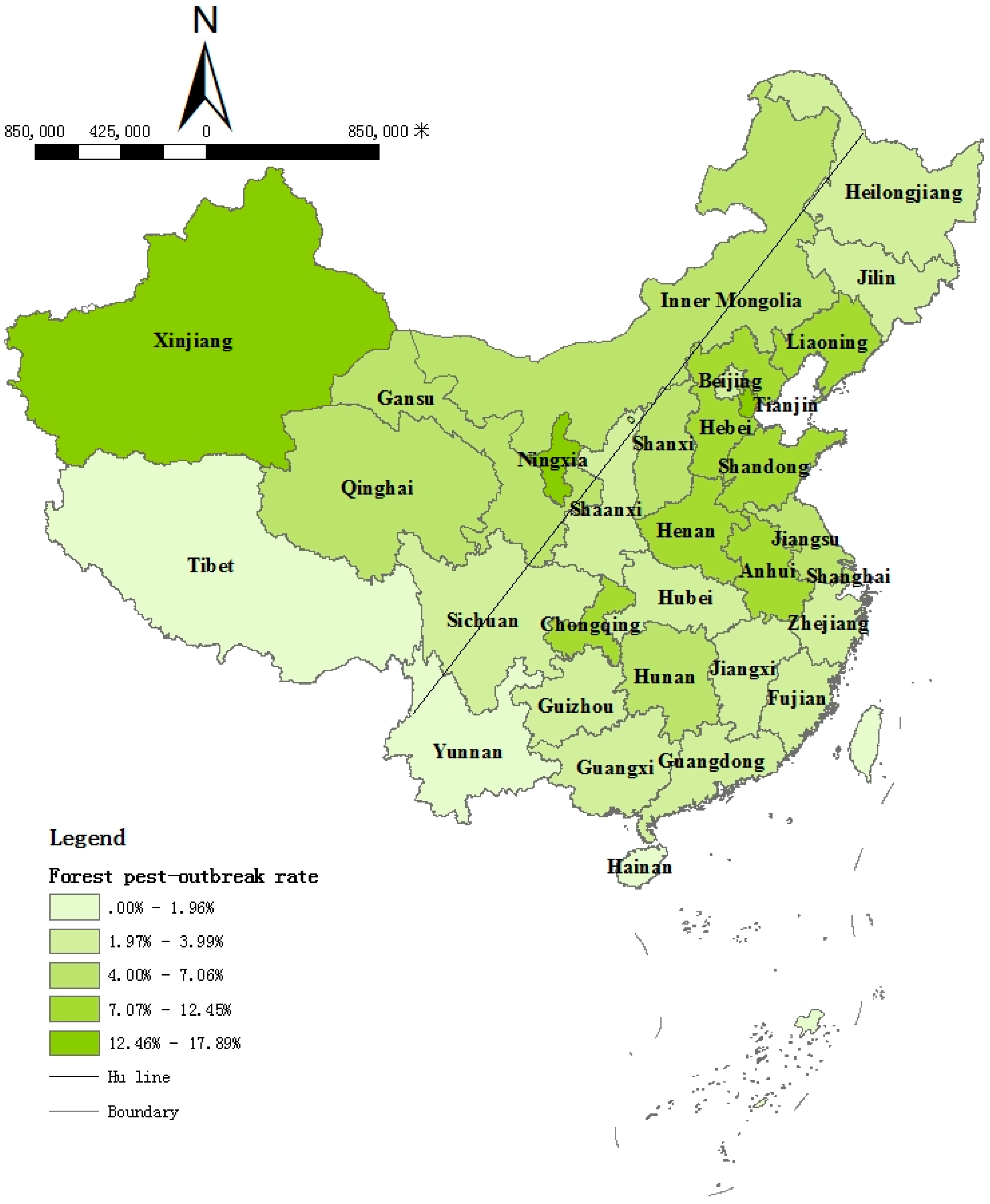
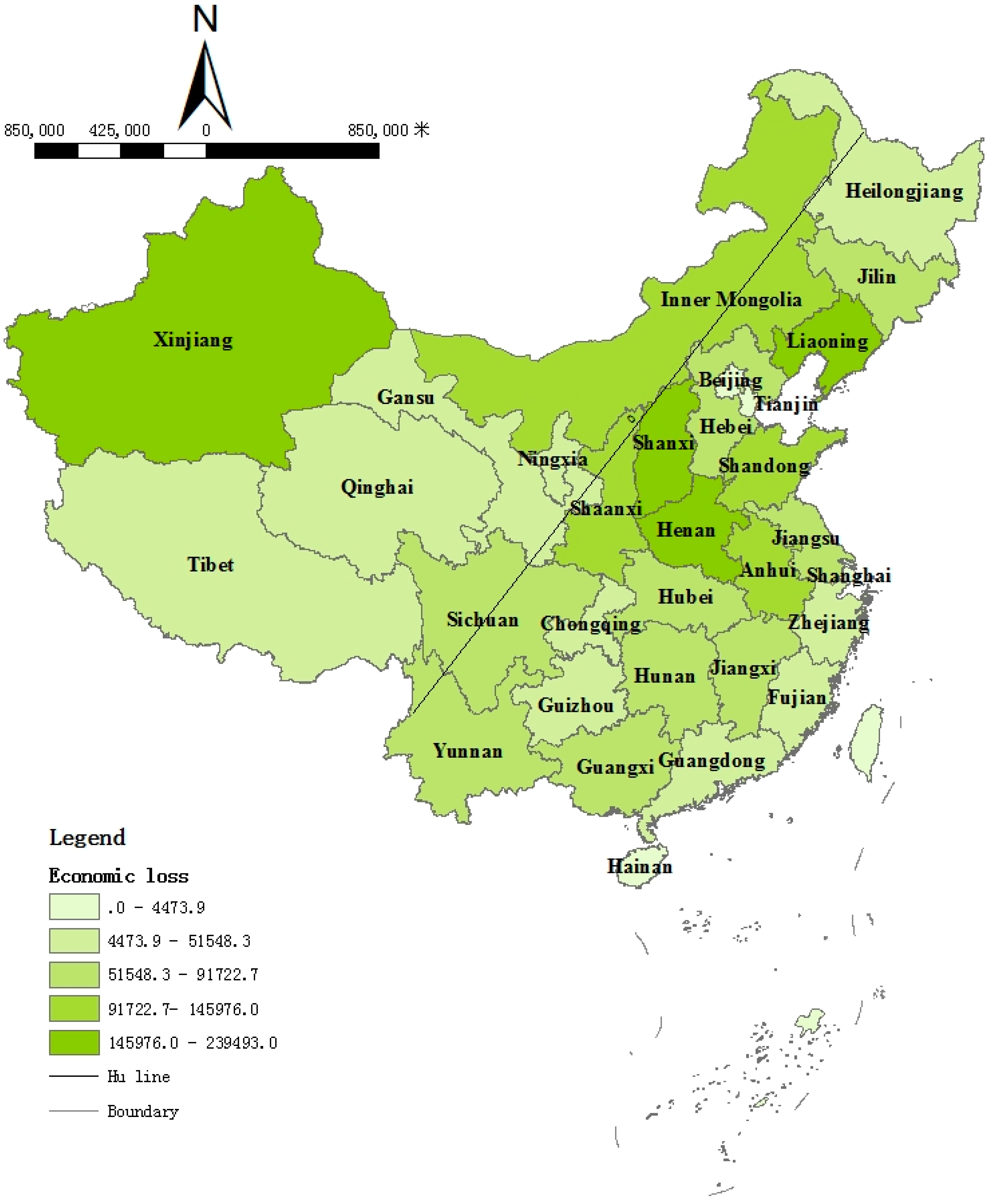
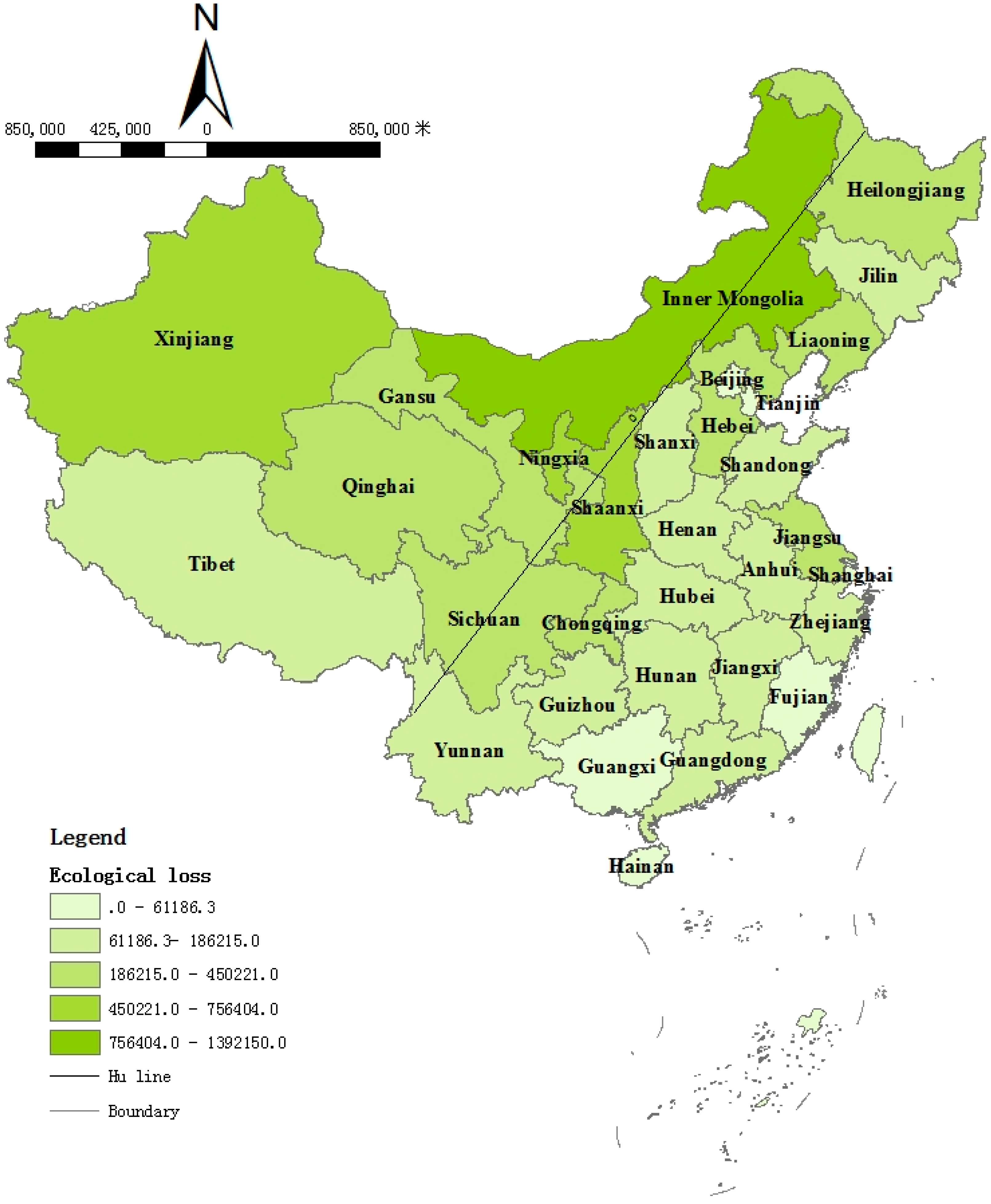
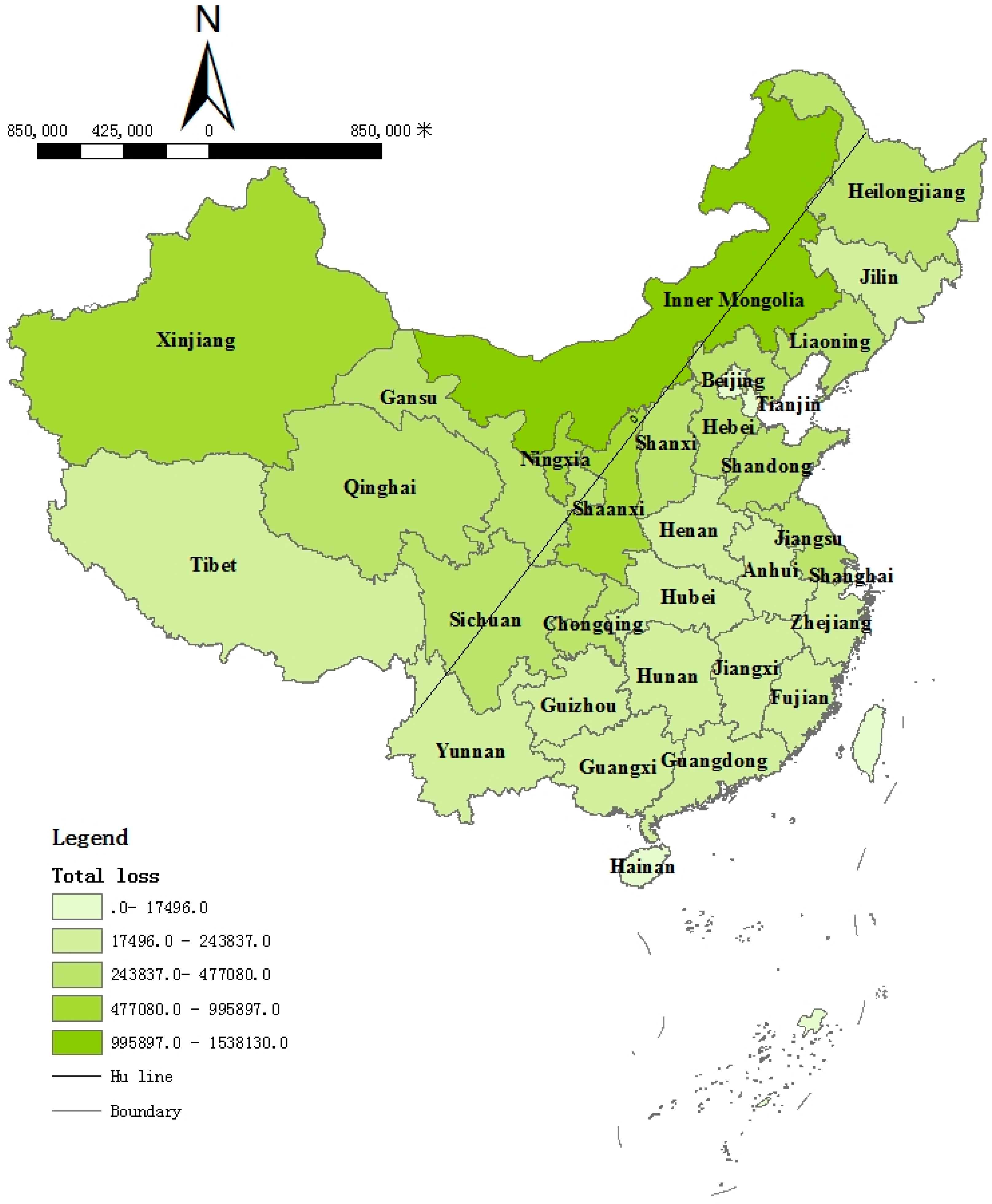
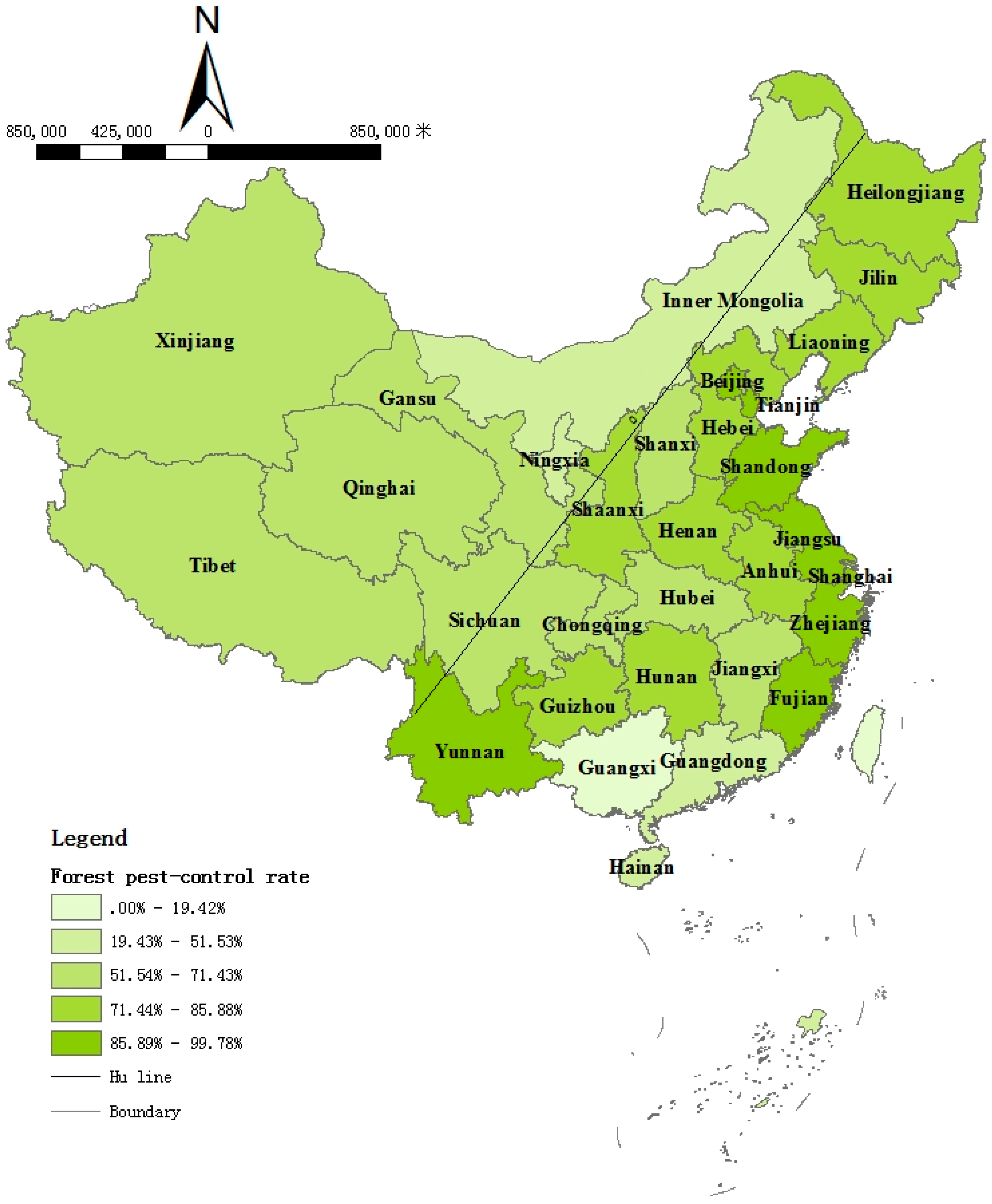
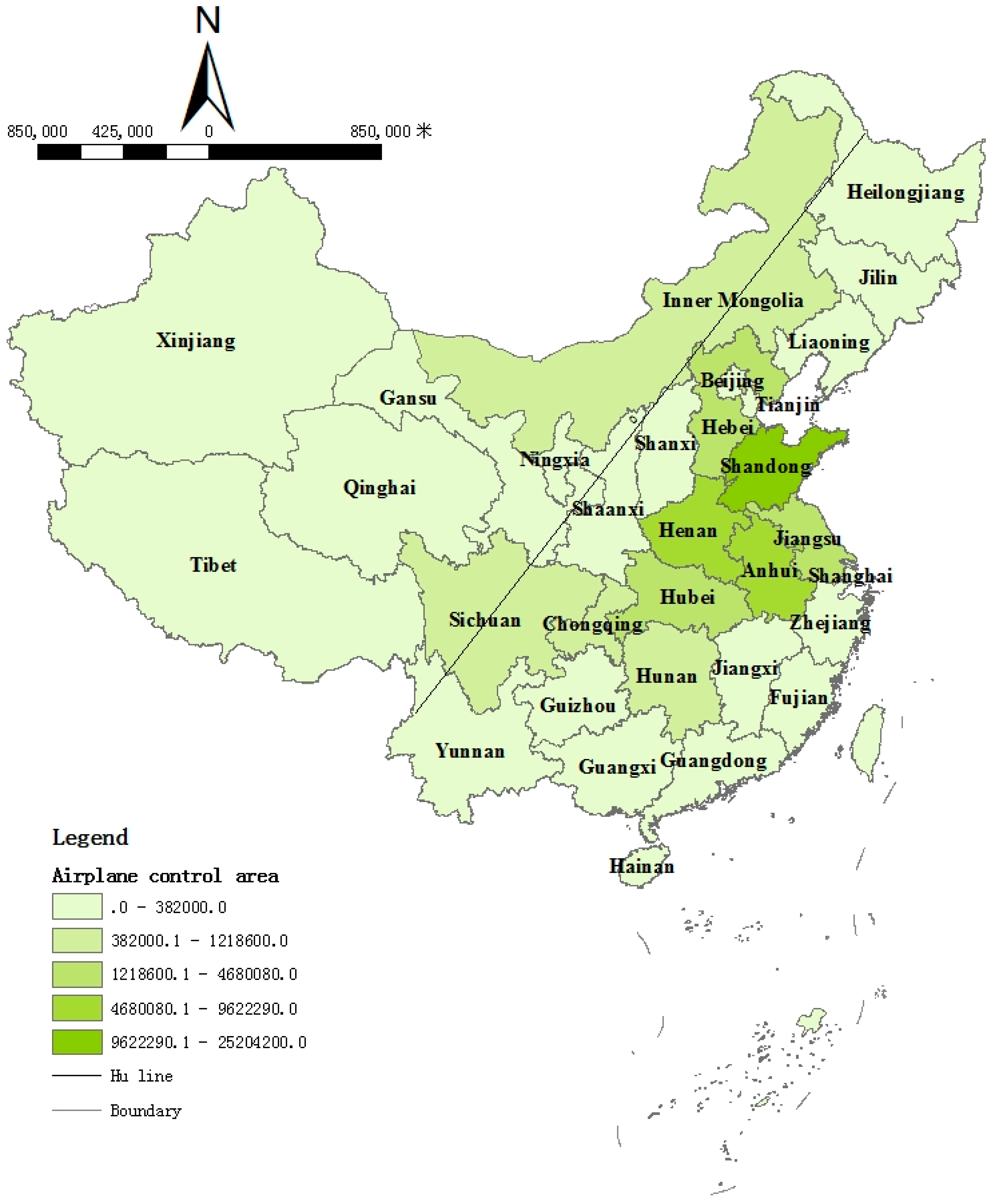
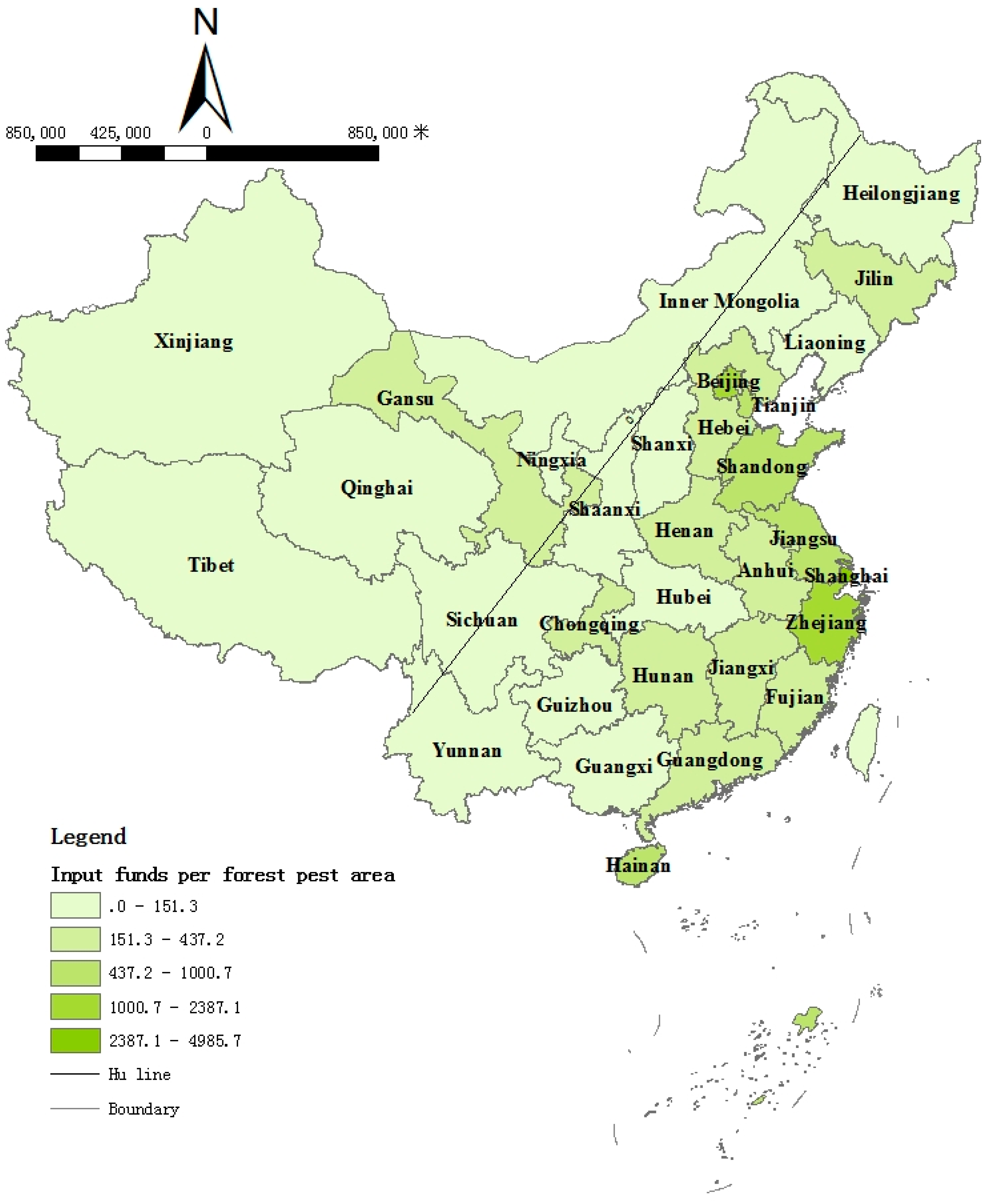
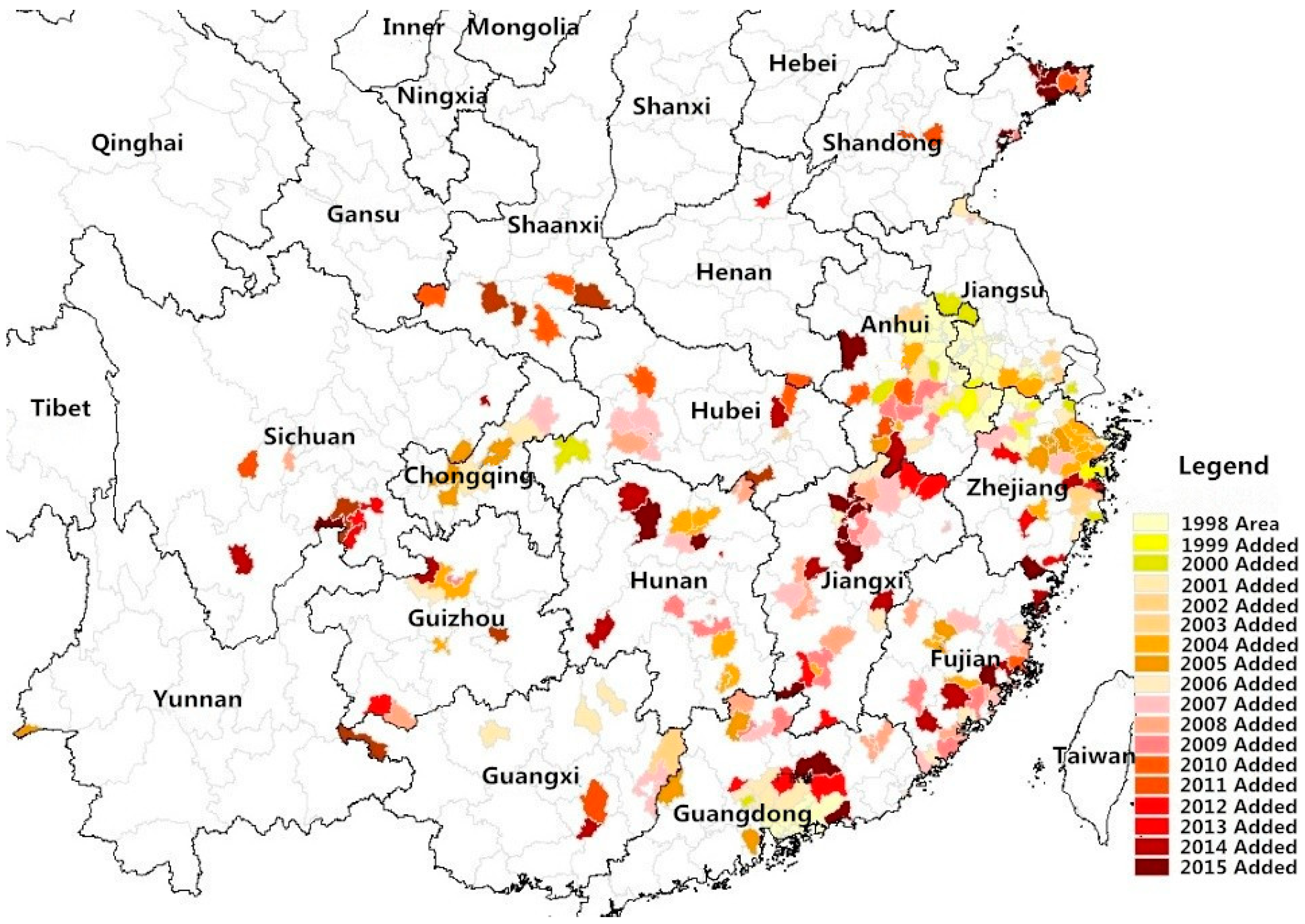
| Ln (Pest Area) | Ln (Control Area) | Ln (Funds) | ||||||
|---|---|---|---|---|---|---|---|---|
| Coef. | Z Value | Coef. | Z Value | Coef. | Z Value | |||
| ln(Control Area) | 0.72 *** | 19.07 | ln(Funds) | −0.19 *** | −3.07 | ln(GDP) | 0.71 *** | 18.28 |
| ln(Artificial Forest) | 0.24 *** | 8.3 | ln(workers) | 0.36 *** | 3.98 | |||
| ln(Temperature) | −0.01 | −0.17 | ln(stations) | −0.00 | −0.00 | ln(Forest Income) | 0.14 *** | 4.89 |
| ln(Pressure) | −0.3 *** | −2.69 | ||||||
| ln(Sunshine Hours) | −0.06 | −0.66 | ln(Rural Population) | 0.62 *** | 11.97 | ln(Rural Consumption) | 0.1 * | 1.85 |
| ln(Rainfall) | −0.14 ** | −2.36 | ||||||
| ln(Relative Witness) | −0.45 ** | −2.18 | cons | 7.77 *** | 10.22 | cons | 1.88 *** | 4.08 |
| cons | 5.78 *** | 3.45 | ||||||
| R2 = 0.898 | p = 0.00 | R2 = 0.513 | p = 0.00 | R2 = 0.735 | p = 0.00 | |||
© 2018 by the authors. Licensee MDPI, Basel, Switzerland. This article is an open access article distributed under the terms and conditions of the Creative Commons Attribution (CC BY) license (http://creativecommons.org/licenses/by/4.0/).
Share and Cite
Cai, Q.; Cai, Y.; Wen, Y. Spatially Differentiated Trends between Forest Pest-Induced Losses and Measures for Their Control in China. Sustainability 2019, 11, 73. https://doi.org/10.3390/su11010073
Cai Q, Cai Y, Wen Y. Spatially Differentiated Trends between Forest Pest-Induced Losses and Measures for Their Control in China. Sustainability. 2019; 11(1):73. https://doi.org/10.3390/su11010073
Chicago/Turabian StyleCai, Qi, Yushi Cai, and Yali Wen. 2019. "Spatially Differentiated Trends between Forest Pest-Induced Losses and Measures for Their Control in China" Sustainability 11, no. 1: 73. https://doi.org/10.3390/su11010073
APA StyleCai, Q., Cai, Y., & Wen, Y. (2019). Spatially Differentiated Trends between Forest Pest-Induced Losses and Measures for Their Control in China. Sustainability, 11(1), 73. https://doi.org/10.3390/su11010073





